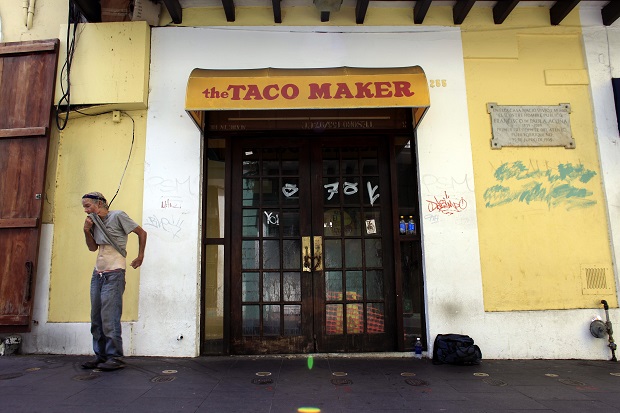Puerto Rico defaults on debt; misery deepens

A homeless man stands in front of a closed down fast food restaurant in the colonial district of Old San Juan, Puerto Rico, Sunday, August 2, 2015. As Puerto Rico’s economy continues to decline a list of cost-cutting measures proposed by a group of hedge funds that holds $5.2 billion of Puerto Rico’s debt has riled islanders: laying off teachers; cutting Medicaid benefits; and reducing subsidies to the main public university. AP
SAN JUAN, Puerto Rico — Most tables are empty at Walter Martin’s coffee shop in San Juan’s colonial district. His brow is furrowed with concern and glistens with sweat in the sweltering Caribbean morning.
He’s turned off the air conditioning to lower his power bill. With fewer customers, he’s cut staff hours and tried to make up the lost income by raising some prices. But Puerto Rico’s entrenched economic crisis is leading people to either cut their personal spending to the basics or flee to the mainland to search for jobs, contributing to the struggles of those left on the island.
“We’re making every single adjustment needed,” Martin said. “We have to make these decisions because if not …”
He trailed off, hesitant to complete the sentence.
Nearly 10 years into a deep economic slump, Puerto Rico is no closer to pulling out, and, in fact, is poised to plummet further. The unemployment rate is above 12 percent. Some 144,000 people left the U.S. territory between 2010 and 2013, and about a third of all people born in Puerto Rico now live in the U.S. mainland. Schools and businesses have closed amid the exodus. The population of 3.5 million is expected to drop to 3 million by 2050.
The government has tried to boost revenue by hiking the sales tax to 11.5 percent, higher than any U.S. state, and closing government offices. Its debt-burdened power utility already charges rates that on average are twice those of the mainland, and is under pressure from bondholders to raise them higher.
A $58 million bond payment due Saturday went unpaid, with the government making only a partial interest payment of $628,000 in what Moody’s Investors Service characterized as a sign of further missed payments to come.
“This is a first in what we believe will be broad defaults on commonwealth debt,” Moody’s Vice President Emily Raimes said Monday.